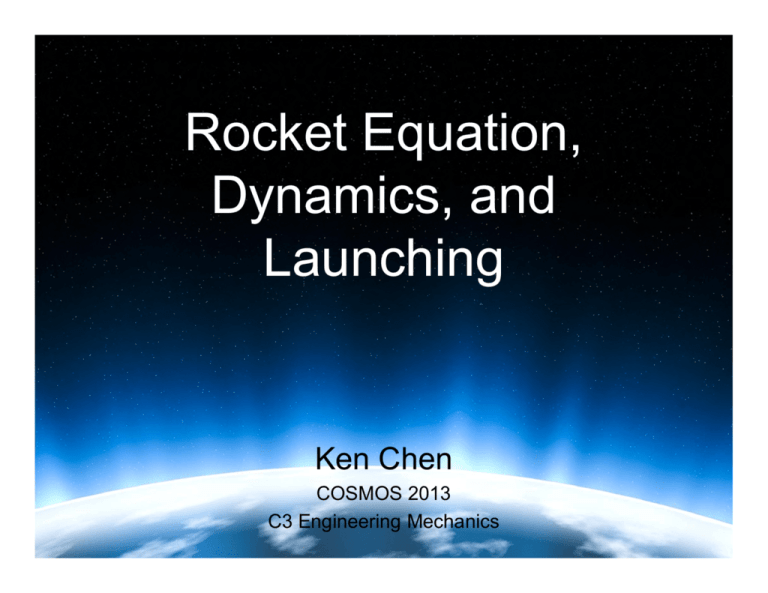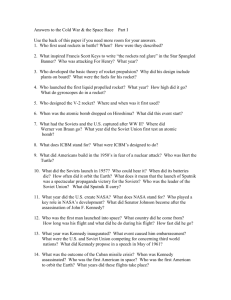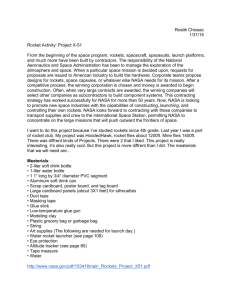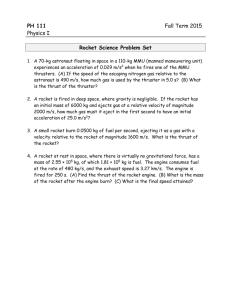Rocket Equation, Dynamics, and Launching
advertisement

Rocket Equation, Dynamics, and Launching Ken Chen COSMOS 2013 C3 Engineering Mechanics Why Rockets? • Imagine a world where you didn’t have these: – – – – Cell phones Television Internet GPS Navigation • Rockets are used for: – Space transportation/exploration – Satellite communications – Military weaponry Thank rockets! Parts of a Rocket http://exploration.grc.nasa.gov/education/rocket/Images/rockpart if Forces on a Rocket • On Center of Gravity (CG) – Weight – Thrust (mostly) • On Center of Pressure (CP) (Aerodynamic) – Lift – Drag http://exploration.grc.nasa.gov/education/rocket/rktaero.ht l Thrust • Thrust-Newton’s third law – Rocket pushes on propellant, propellant pushes back on rocket – Thrust equation: F thrust m ve ( pe p0 ) Ae • Ways to increase thrust: – Maximize mass flow rate – Maximize exit velocity to incoming velocity • Correction term ( p p ) A e 0 e – Pressure difference Drag • Frictional drag – Caused by friction of fluid against the surface of the body 1 2 • Pressure/Form drag D v AC D 2 – Different shapes and sizes – Vortices in the wake of the body • Wave drag – Common at transonic and supersonic speeds – Can reach up to 4x subsonic drag Control • CP below CG – stable equilibrium • Gimbaled Thrust – Nozzle can be shifted/rotated; changes direction of thrust • Vernier Rocket – Small additional rocket engines http://exploration.grc.nasa.gov/education/rocket/rktcontrl.html Konstantin E. Tsiolkovsky (18571935) • Early education impaired by deafness • College – Moscow • Studied mathematics and science – Monoplane – Wind tunnel http://www.allstar.fiu.edu/aero/images/Tsiolkovsky.jpg Tsiolkovsky’s Contributions • Rocket equation – Still remains the basis of all rocket dynamics today • Founder of rocket dynamics – Understood dynamics of firework rockets through math and physics • Anthropocosmism – Humans will dominate space • Inspired several other great minds in rocketry Robert H. Goddard (1882-1945) • Masterful physicist and inventor • Built/tested first liquid fuel rocket in 1926 • Patented multi-stage rocket in 1914 • German V2 missiles – Steering, vanes http://www.rugusavay.com/wp-content/uploads/2013/03/Robert-Goddard-4.jpg Tsiolkovsky Rocket Equation m0 V Veq ln m f Derivation: – Conservation of momentum dp F 0 dt dp p(t dt ) p (t ) m v p(t ) m v (v dv) ve dm m dm p(t dt ) (m dm) (v dv) dm (v dv ve ) dp (m dm) (v dv) dm (v dv ve ) mv dp mv mv vdm vdm dmdv dmdv mdv ve dm dp mdv ve dm 0 dp mdv ve dm 0 v dv Flip sign Tsiolkovsky Rocket Equation (cont.) A parallel: dp mdv ve dm 0 v dv e dm m Newton’s Second Law 1 dv v dm e v0 m0 m v f v0 ve (ln(m f ) ln(m0 )) vf mf m0 v ve ln m f Ideal Rocket Equation •Constant Mass Fnet m a •Variable Mass Fnet d (mv) dv dm m v dt dt dt Specific Impulse Isp • A way to measure engine efficiency F I sp m g • Can also be used to determine thrust What actually happens - Launching • Potentially dangerous – Astronauts bear about 3 g’s of acceleration – Requires a high amount of precision – Sound energy can cause damage • Liftoff process – Entire process controlled by computers – Increase in air pressure – overstressing – Need enough thrust Future Rocket Dynamics • Nuclear Propulsion – Abandoned in 1972 (Project Rover) – Comeback? • ANTIMATTER Propulsion – Involves the annihilation of matter – Efficiency is incomparable – interstellar missions http://static.ddmcdn.com/gif/antimatter-1.jpg More on Antimatter Propulsion • When combining electron with anti-electron – Photons (gamma rays) e e 2 • Proton with anti-proton o – Pions p p n n n • Decay into muons and neutrinos • Eventually all annihilate or decay into massless particles, photons, and neutrinos • Facts – Exhaust velocity ~0.95 c – Storage and production of antiprotons • 1 ng/year • Comparison – Apollo 11 took 4 days to reach the moon – In 4 days, a pion antimatter rocket can travel from Earth to Sun 350 times References • • • • • • • • "Basic Rocket Motion." Guided Tours. Ed. Tom Benson. NASA, n.d. Web. 29 July 2013. Braeunig, Robert A. "Basics of Space Flight: Rocket Propulsion." Rocket and Space Technology. N.p., 2012. Web. 29 July 2013. Brewster, Isaac. "The Physics Behind The Rocket." The Physics of Rockets. University of Alaska Fairbanks, 31 Oct. 2000. Web. 29 July 2013. Dunbar, Brian. "Konstantin E. Tsiolkovsky." NASA. NASA, 20 Sept. 2010. Web. 01 Aug. 2013. Dunbar, Brian. "Societal Impact of the Space Age." NASA. NASA, 07 Nov. 2005. Web. 29 July 2013. Dunbar, Brian. "What Is a Rocket?" NASA. NASA, 12 July 2011. Web. 29 July 2013. Garner, Rob. "Robert H. Goddard." NASA. NASA, 28 July 2013. Web. 01 Aug. 2013. Hafez, Mohamed M. "COSMOS Engineering Mechanics." COSMOS 2013. Davis, California. July 2013. Lecture. References (cont.) • • • • • • • Keith, Edward L. "Fundamentals of Rockets and Missiles." Laurel, Maryland. Lecture. Krempetz, Kurt. "Freeflight Trimming." AMA Glider. Academy of Model Aeronautics, May 2006. Web. 29 July 2013. Portland State Aerospace Society. "Simple Rocket Science." Simplerockets 1d. Portland State University, 02 Mar. 2010. Web. 29 July 2013. Qualitative Reasoning Group. "Propulsion." How Are Rockets Designed? Northwestern University, n.d. Web. 29 July 2013. Turner, Martin J. L. Rocket and Spacecraft Propulsion: Principles, Practice and New Developments. Berlin: Springer, 2009. Print. Walter, Ulrich. Astronautics. Weinheim: Wiley-VCH, 2008. Print. Wilkinson, Peter. "Rocket Launch and Reentry." Senior Science. St. Francis Xavier's College, Hamilton, n.d. Web.








